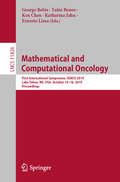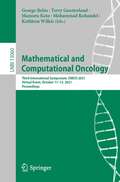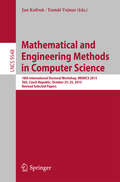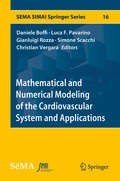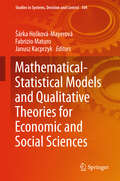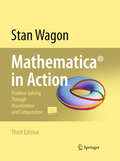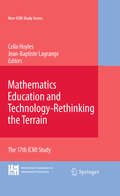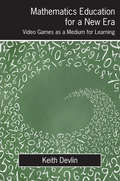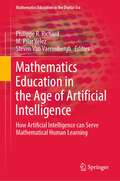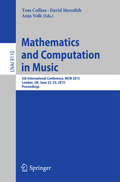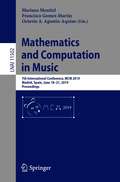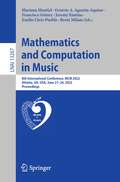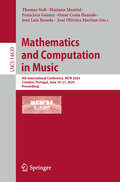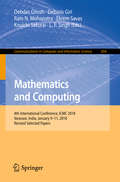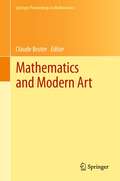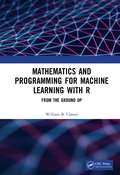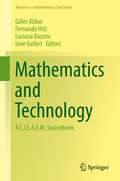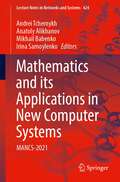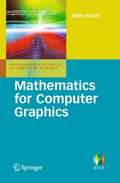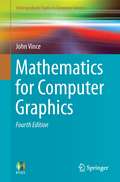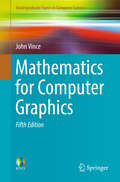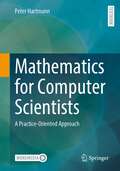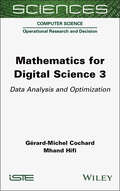- Table View
- List View
Mathematical and Computational Oncology: First International Symposium, ISMCO 2019, Lake Tahoe, NV, USA, October 14–16, 2019, Proceedings (Lecture Notes in Computer Science #11826)
by Ken Chen George Bebis Takis Benos Katharina Jahn Ernesto LimaThis book constitutes the refereed proceedings of the First International Symposium on Mathematical and Computational Oncology, ISMCO'2019, held in Lake Tahoe, NV, USA, in October 2019. The 7 full papers presented were carefully reviewed and selected from 30 submissions. The papers are organized in topical sections named: Tumor evolvability and intra-tumor heterogeneity; Imaging and scientific visualization for cancer research; Statistical methods and data mining for cancer research (SMDM); Spatio-temporal tumor modeling and simulation (STTMS).
Mathematical and Computational Oncology: Second International Symposium, ISMCO 2020, San Diego, CA, USA, October 8–10, 2020, Proceedings (Lecture Notes in Computer Science #12508)
by George Bebis Max Alekseyev Heyrim Cho Jana Gevertz Maria Rodriguez MartinezThis book constitutes the refereed proceedings of the Second International Symposium on Mathematical and Computational Oncology, ISMCO 2020, which was supposed to be held in San Diego, CA, USA, in October 2020, but was instead held virtually due to the COVID-19 pandemic.The 6 full papers and 4 short papers presented together with 1 invited talk were carefully reviewed and selected from 28 submissions. The papers are organized in topical sections named: statistical and machine learning methods for cancer research; mathematical modeling for cancer research; general cancer computational biology; and posters.
Mathematical and Computational Oncology: Third International Symposium, ISMCO 2021, Virtual Event, October 11–13, 2021, Proceedings (Lecture Notes in Computer Science #13060)
by George Bebis Terry Gaasterland Mamoru Kato Mohammad Kohandel Kathleen WilkieThis book constitutes the refereed proceedings of the Third International Symposium on Mathematical and Computational Oncology, ISMCO 2021, held in October 2021. Due to COVID-19 pandemic the conference was held virtually.The 3 full papers and 4 short papers presented were carefully reviewed and selected from 20 submissions. The papers are organized in topical sections named: statistical and machine learning methods for cancer research; mathematical modeling for cancer research; spatio-temporal tumor modeling and simulation; general cancer computational biology; mathematical modeling for cancer research; computational methods for anticancer drug development.
Mathematical and Engineering Methods in Computer Science
by Jan Kofroň Tomáš VojnarThis volume contains the post-conference proceedings of the 10th Doctoral Workshop on Mathematical and Engineering Methods in Computer Science, MEMICS 2015, held in Telč, Czech Republic, in October 2015. The 10 thoroughly revised full papers were carefully selected out of 25 submissions and are presented together with 3 invited papers. The topics covered include: security and safety, bioinformatics, recommender systems, high-performance and cloud computing, and non-traditional computational models (quantum computing, etc. ).
Mathematical and Numerical Modeling of the Cardiovascular System and Applications (SEMA SIMAI Springer Series #16)
by Gianluigi Rozza Daniele Boffi Simone Scacchi Luca F. Pavarino Christian VergaraThe book comprises contributions by some of the most respected scientists in the field of mathematical modeling and numerical simulation of the human cardiocirculatory system. It covers a wide range of topics, from the assimilation of clinical data to the development of mathematical and computational models, including with parameters, as well as their efficient numerical solution, and both in-vivo and in-vitro validation. It also considers applications of relevant clinical interest. This book is intended for graduate students and researchers in the field of bioengineering, applied mathematics, computer, computational and data science, and medicine wishing to become involved in the highly fascinating task of modeling the cardiovascular system.
Mathematical-Statistical Models and Qualitative Theories for Economic and Social Sciences
by Janusz Kacprzyk Šárka Hošková-Mayerová Fabrizio MaturoThis book presents a broad spectrum of problems related to statistics, mathematics, teaching, social science, and economics as well as a range of tools and techniques that can be used to solve these problems. It is the result of a scientific collaboration between experts in the field of economic and social systems from the University of Defence in Brno (Czech Republic), G. d'Annunzio University of Chieti-Pescara (Italy), Pablo de Olavid eUniversity of Sevilla (Spain), and Ovidius University in Constanţa, (Romania). The studies included were selected using a peer-review process and reflect heterogeneity and complexity of economic and social phenomena. They and present interesting empirical research from around the globe and from several research fields, such as statistics, decision making, mathematics, complexity, psychology, sociology and economics. The volume is divided into two parts. The first part, "Recent trends in mathematical and statistical models for economic and social sciences", collects papers on quantitative matters, which propose mathematical and statistical models for social sciences, economics, finance, and business administration. The second part, "Recent trends in qualitative theories for economic and social sciences", includes papers on qualitative matters, which discuss social, economic, and teaching issues. It is an ideal reference work for all those researchers interested in recent quantitative and qualitative tools. Covering a wide range of topics, it appeals in equal measure to mathematicians, statisticians, sociologists, philosophers, and specialists in the fields of communication, social and political sciences.
Mathematica® in Action
by Stan WagonPlenty of examples and case studies utilize Mathematica 7's newest tools, such as dynamic manipulations and adaptive three-dimensional plotting. Emphasizes the breadth of Mathematica and the impressive results of combining techniques from different areas. Whenever possible, the book shows how Mathematica can be used to discover new things. Striking examples include the design of a road on which a square wheel bike can ride, the design of a drill that can drill square holes, and new and surprising formulas for p. Visualization is emphasized throughout, with finely crafted graphics in each chapter.
Mathematics Education and Technology-Rethinking the Terrain
by Celia Hoyles Jean-Baptiste LagrangeMathematics Education and Technology-Rethinking the Terrain revisits the important 1985 ICMI Study on the influence of computers and informatics on mathematics and its teaching. The focus of this book, resulting from the seventeenth Study led by ICMI, is the use of digital technologies in mathematics teaching and learning in countries across the world. Specifically, it focuses on cultural diversity and how this diversity impinges on the use of digital technologies in mathematics teaching and learning. Within this focus, themes such as mathematics and mathematical practices; learning and assessing mathematics with and through digital technologies; teachers and teaching; design of learning environments and curricula; implementation of curricula and classroom practice; access, equity and socio-cultural issues; and connectivity and virtual networks for learning, serve to organize the study and bring it coherence. Providing a state-of-the-art view of the domain with regards to research, innovating practices and technological development, Mathematics Education and Technology-Rethinking the Terrain is of interest to researchers and all those interested in the role that digital technology plays in mathematics education.
Mathematics Education for a New Era: Video Games as a Medium for Learning
by Keith DevlinStanford mathematician and NPR Math Guy Keith Devlin explains why, fun aside, video games are the ideal medium to teach middle-school math. Aimed primarily at teachers and education researchers, but also of interest to game developers who want to produce videogames for mathematics education, Mathematics Education for a New Era: Video Games as a Med
Mathematics Education in Brazil: Panorama of Current Research
by Alessandro Jacques Ribeiro Lulu Healy Rute Elizabete Borba Solange Hassan FernandesThis book presents, for the first time in English, the state of the art of Mathematics Education research in Brazil, a country that has the strongest community in this field in Latin America. Edited by leading researchers in the area, the volume provides the international academic community a summary of the scientific production of the thirteen working groups of the Brazilian Society of Mathematics Education (SBEM), the national scientific society that brings together researchers, teachers, students and other professionals of the area. These working groups meet every three years at the International Seminar of Mathematics Education (SIPEM) and cover the following topics: Mathematics Education in the Early Years and Primary Education (Y1-Y5); Mathematics Education in the Middle School (Y6-Y9); Mathematics Education in the High School (Y10-Y12); Mathematics Education at the University level; History of Mathematics, Culture and Mathematics Education; Digital Technologies and Distance Education; Teacher Education; Assessment and Mathematics Education; Cognitive and Linguistic Processes in Mathematics Education; Mathematical Modeling; Philosophy of Mathematics Education, Teaching Probability and Statistics; and Difference, Inclusion and Mathematics Education. Each chapter of the book presents an overview of the production of a working group and they are all preceded by an introduction by professor Ubiratan D’Ambrosio, one of the pioneers of Mathematics Education in Brazil.
Mathematics Education in the Age of Artificial Intelligence: How Artificial Intelligence can Serve Mathematical Human Learning (Mathematics Education in the Digital Era #17)
by Philippe R. Richard M. Pilar Vélez Steven Van VaerenberghThis book highlights the contribution of artificial intelligence for mathematics education. It provides concrete ideas supported by mathematical work obtained through dynamic international collaboration, and discusses the flourishing of new mathematics in the contemporary world from a sustainable development perspective. Over the past thirty years, artificial intelligence has gradually infiltrated all facets of society. When it is deployed in interaction with the human designer or user, AI certainly raises new ethical questions. But as soon as it aims to augment intelligence in a kind of human-machine partnership, it goes to the heart of knowledge development and the very performance of work. The proposed themes and the sections of the book address original issues relating to the creation of AI milieus to work on mathematics, to the AI-supported learning of mathematics and to the coordination of « usual » paper/pencil techniques and « new » AI-aided educational working spaces. The authors of the book and the coordinators of each section are all established specialists in mathematics didactics, mathematics and computer science. In summary, this book is a must-read for everyone interested in the teaching and learning of mathematics, and it concerns the interaction between the human and the machine in both directions. It contains ideas, questions and inspiration that invite to take up the challenge of Artificial Intelligence contributing to Mathematical Human Learning.
Mathematics and Computation in Music
by David Meredith Tom Collins Anja VolkThis book constitutes the thoroughly refereed proceedings of the 5th International Conference on Mathematics and Computation in Music, MCM 2015, held in London, UK, in June 2015. The 24 full papers and 14 short papers presented were carefully reviewed and selected from 64 submissions. The papers feature research that combines mathematics or computation with music theory, music analysis, composition, and performance. They are organized in topical sections on notation and representation, music generation, patterns, performance, similarity and contrast, post-tonal music analysis, geometric approaches, deep learning, and scales.
Mathematics and Computation in Music: 7th International Conference, MCM 2019, Madrid, Spain, June 18–21, 2019, Proceedings (Lecture Notes in Computer Science #11502)
by Octavio A. Agustín-Aquino Mariana Montiel Francisco Gomez-MartinThis book constitutes the thoroughly refereed proceedings of the 7th International Conference on Mathematics and Computation in Music, MCM 2019, held in Madrid, Spain, in June 2019. The 22 full papers and 10 short papers presented were carefully reviewed and selected from 48 submissions. The papers feature research that combines mathematics or computation with music theory, music analysis, composition, and performance. They are organized in topical sections on algebraic and other abstract mathematical approaches to understanding musical objects; remanaging Riemann: mathematical music theory as “experimental philosophy”?; octave division; computer-based approaches to composition and score structuring; models for music cognition and beat tracking; pedagogy of mathematical music theory.The chapter “Distant Neighbors and Interscalar Contiguities” is available open access under a Creative Commons Attribution 4.0 International License via link.springer.com.
Mathematics and Computation in Music: 8th International Conference, MCM 2022, Atlanta, GA, USA, June 21–24, 2022, Proceedings (Lecture Notes in Computer Science #13267)
by Octavio A. Agustín-Aquino Emilio Lluis-Puebla Mariana Montiel Francisco Gómez Jeremy Kastine Brent MilamThis book constitutes the thoroughly refereed proceedings of the 8th International Conference on Mathematics and Computation in Music, MCM 2022, held in Atlanta, GA, USA, in June 2022. The 29 full papers and 8 short papers presented were carefully reviewed and selected from 45 submissions. The papers feature research that combines mathematics or computation with music theory, music analysis, composition, and performance. They are organized in Mathematical Scale and Rhythm Theory: Combinatorial, Graph Theoretic, Group Theoretic and Transformational Approaches; Categorical and Algebraic Approaches to Music; Algorithms and Modeling for Music and Music-Related Phenomena; Applications of Mathematics to Musical Analysis; Mathematical Techniques and Microtonality
Mathematics and Computation in Music: 9th International Conference, MCM 2024, Coimbra, Portugal, June 18–21, 2024, Proceedings (Lecture Notes in Computer Science #14639)
by Thomas Noll Mariana Montiel Francisco Gómez Omar Costa Hamido José Luis Besada José Oliveira MartinsThis book constitutes the refereed proceedings of the 9th International Conference on Mathematics and Computation in Music, MCM 2024, held in Coimbra, Portugal, during June 18–21, 2024. The 30 full papers and 9 short papers included in this book were carefully reviewed and selected from 45 submissions. They were organized in topical sections as follows: mathematical scale theory and tuning; rhythm analysis and rhythm generation; categorical and algebraic approaches to music; quantum music; theory and algorithms for melodic- harmonic analysis and generation; geometric approaches to musical algorithms and microtonality; fourier analysis for music; similarity and distance measures for music; short papers; communication-performances; and tribute to Yves Hellegouarch.
Mathematics and Computing: Icmc, Haldia, India, January 2015 (Springer Proceedings In Mathematics And Statistics Series #139)
by Ram N. Mohapatra Debasis Giri Debdas Ghosh Ekrem Savas Kouichi Sakurai L. P. SinghThis book constitutes the proceedings of the 4th International Conference on Mathematics and Computing, ICMC 2018, held in Varanasi, India, in January 2018.The 29 papers presented in this volume were carefully reviewed and selected from 116 submissions. They are organized in topical sections on security and coding theory; computing; applied mathematics; pure mathematics.
Mathematics and Modern Art
by Claude BruterThe link between mathematics and art remains as strong today as it was in the earliest instances of decorative and ritual art. Arts, architecture, music and painting have for a long time been sources of new developments in mathematics, and vice versa. Many great painters have seen no contradiction between artistic and mathematical endeavors, contributing to the progress of both, using mathematical principles to guide their visual creativity, enriching their visual environment with the new objects created by the mathematical science. Owing to the recent development of the so nice techniques for visualization, while mathematicians can better explore these new mathematical objects, artists can use them to emphasize their intrinsic beauty, and create quite new sceneries. This volume, the content of the first conference of the European Society for Mathematics and the Arts (ESMA), held in Paris in 2010, gives an overview on some significant and beautiful recent works where maths and art, including architecture and music, are interwoven. The book includes a wealth of mathematical illustrations from several basic mathematical fields including classical geometry, topology, differential geometry, dynamical systems. Here, artists and mathematicians alike elucidate the thought processes and the tools used to create their work
Mathematics and R Programming for Machine Learning: From the Ground Up
by William B. ClasterBased on the author’s experience in teaching data science for more than 10 years, Mathematics and Programming for Machine Learning with R: From the Ground Up reveals how machine learning algorithms do their magic and explains how these algorithms can be implemented in code. It is designed to provide readers with an understanding of the reasoning behind machine learning algorithms as well as how to program them. Written for novice programmers, the book progresses step-by-step, providing the coding skills needed to implement machine learning algorithms in R. The book begins with simple implementations and fundamental concepts of logic, sets, and probability before moving to the coverage of powerful deep learning algorithms. The first eight chapters deal with probability-based machine learning algorithms, and the last eight chapters deal with machine learning based on artificial neural networks. The first half of the book does not require mathematical sophistication, although familiarity with probability and statistics would be helpful. The second half assumes the reader is familiar with at least one semester of calculus. The text guides novice R programmers through algorithms and their application and along the way; the reader gains programming confidence in tackling advanced R programming challenges. Highlights of the book include: More than 400 exercises A strong emphasis on improving programming skills and guiding beginners to the implementation of full-fledged algorithms Coverage of fundamental computer and mathematical concepts including logic, sets, and probability In-depth explanations of machine learning algorithms
Mathematics and Technology
by Uwe Gellert Gilles Aldon Fernando Hitt Luciana BazziniThis volume collects most recent work on the role of technology in mathematics education. It offers fresh insight and understanding of the many ways in which technological resources can improve the teaching and learning of mathematics. The first section of the volume focuses on the question how a proposed mathematical task in a technological environment can influence the acquisition of knowledge and what elements are important to retain in the design of mathematical tasks in computing environments. The use of white smart boards, platforms as Moodle, tablets and smartphones have transformed the way we communicate both inside and outside the mathematics classroom. Therefore the second section discussed how to make efficient use of these resources in the classroom and beyond. The third section addresses how technology modifies the way information is transmitted and how mathematical education has to take into account the new ways of learning through connected networks as well as new ways of teaching. The last section is on the training of teachers in the digital era. The editors of this volume have selected papers from the proceedings of the 65th, 66th and 67th CIEAEM conference, and invited the correspondent authors to contribute to this volume by discussing one of the four important topics. The book continues a series of sourcebooks edited by CIEAEM, the Commission Internationale pour l'#65533;tude et l'Am#65533;lioration de l'Enseignement des Math#65533;matiques / International Commission for the Study and Improvement of Mathematics Education.
Mathematics and its Applications in New Computer Systems: MANCS-2021 (Lecture Notes in Networks and Systems #424)
by Andrei Tchernykh Irina Samoylenko Anatoly Alikhanov Mikhail BabenkoThis book is based on the best papers accepted for presentation during the International Conference on Mathematics and its Applications in New Computer Systems (MANCS-2021), Russia.The book includes research materials on modern mathematical problems, solutions in the field of cryptography, data analysis and modular computing, as well as scientific computing. The scope of numerical methods in scientific computing presents original research, including mathematical models and software implementations, related to the following topics: numerical methods in scientific computing; solving optimization problems; methods for approximating functions, etc. The studies in mathematical solutions to cryptography issues are devoted to secret sharing schemes, public key systems, private key systems, n-degree comparisons, modular arithmetic of simple, addition of points of an elliptic curve, Hasse theorem, homomorphic encryption and learning with error, and modifications of the RSA system. Furthermore, issues in data analysis and modular computing include contributions in the field of mathematical statistics, machine learning methods, deep learning, and neural networks. Finally, the book gives insights into the fundamental problems in mathematics education. The book intends for readership specializing in the field of cryptography, information security, parallel computing, computer technology, and mathematical education.
Mathematics for Computer Graphics
by John A. VinceJohn Vince explains a wide range of mathematical techniques and problem-solving strategies associated with computer games, computer animation, virtual reality, CAD, and other areas of computer graphics. Covering all the mathematical techniques required to resolve geometric problems and design computer programs for computer graphic applications, each chapter explores a specific mathematical topic prior to moving forward into the more advanced areas of matrix transforms, 3D curves and surface patches. Problem-solving techniques using vector analysis and geometric algebra are also discussed. All the key areas are covered including: Numbers, Algebra, Trigonometry, Coordinate geometry, Transforms, Vectors, Curves and surfaces, Barycentric coordinates, Analytic geometry. Plus - and unusually in a student textbook - a chapter on geometric algebra is included.
Mathematics for Computer Graphics
by John VinceJohn Vince explains a wide range of mathematical techniques and problem-solving strategies associated with computer games, computer animation, virtual reality, CAD and other areas of computer graphics in this updated and expanded fourth edition. The first four chapters revise number sets, algebra, trigonometry and coordinate systems, which are employed in the following chapters on vectors, transforms, interpolation, 3D curves and patches, analytic geometry and barycentric coordinates. Following this, the reader is introduced to the relatively new topic of geometric algebra, and the last two chapters provide an introduction to differential and integral calculus, with an emphasis on geometry. Mathematics for Computer Graphics covers all of the key areas of the subject, including: Number sets Algebra Trigonometry Coordinate systems Transforms Quaternions Interpolation Curves and surfaces Analytic geometry Barycentric coordinates Geometric algebra Differential calculus Integral calculus This fourth edition contains over 120 worked examples and over 270 illustrations, which are central to the author's descriptive writing style. Mathematics for Computer Graphics provides a sound understanding of the mathematics required for computer graphics, giving a fascinating insight into the design of computer graphics software and setting the scene for further reading of more advanced books and technical research papers.
Mathematics for Computer Graphics
by John VinceJohn Vince explains a wide range of mathematical techniques and problem-solving strategies associated with computer games, computer animation, virtual reality, CAD and other areas of computer graphics in this completely revised and expanded fifth edition. The first five chapters cover a general introduction, number sets, algebra, trigonometry and coordinate systems, which are employed in the following chapters on vectors, matrix algebra, transforms, interpolation, curves and patches, analytic geometry and barycentric coordinates. Following this, the reader is introduced to the relatively new topic of geometric algebra, followed by two chapters that introduce differential and integral calculus. Finally, there is a chapter on worked examples. Mathematics for Computer Graphics covers all of the key areas of the subject, including: #65533; Number sets #65533; Algebra #65533; Trigonometry #65533; Coordinate systems #65533; Determinants#65533; Vectors #65533; Quaternions #65533; Matrix algebra #65533; Geometric transforms #65533; Interpolation #65533; Curves and surfaces #65533; Analytic geometry #65533; Barycentric coordinates #65533; Geometric algebra #65533; Differential calculus #65533; Integral calculus This fifth edition contains over 120 worked examples and over 320 colour illustrations, which are central to the author's descriptive writing style. Mathematics for Computer Graphics provides a sound understanding of the mathematics required for computer graphics, giving a fascinating insight into the design of computer graphics software and setting the scene for further reading of more advanced books and technical research papers.
Mathematics for Computer Scientists: A Practice-Oriented Approach
by Peter HartmannThis textbook contains the mathematics needed to study computer science in application-oriented computer science courses. The content is based on the author's many years of teaching experience.The translation of the original German 7th edition Mathematik für Informatiker by Peter Hartmann was done with the help of artificial intelligence. A subsequent human revision was done primarily in terms of content.Textbook FeaturesYou will always find applications to computer science in this book.Not only will you learn mathematical methods, you will gain insights into the ways of mathematical thinking to form a foundation for understanding computer science.Proofs are given when they help you learn something, not for the sake of proving.Mathematics is initially a necessary evil for many students. The author explains in each lesson how students can apply what they have learned by giving many real world examples, and by constantly cross-referencing math and computer science. Students will see how math is not only useful, but can be interesting and sometimes fun.The ContentSets, logic, number theory, algebraic structures, cryptography, vector spaces, matrices, linear equations and mappings, eigenvalues, graph theory.Sequences and series, continuous functions, differential and integral calculus, differential equations, numerics.Probability theory and statistics.The Target AudiencesStudents in all computer science-related coursework, and independent learners.
Mathematics for Digital Science 3: Data Analysis and Optimization (ISTE Invoiced)
by Mhand Hifi Gérard-Michel CochardOver the past century, advancements in computer science have consistently resulted from extensive mathematical work. Even today, innovations in the digital domain continue to be grounded in a strong mathematical foundation. To succeed in this profession, both today's students and tomorrow’s computer engineers need a solid mathematical background. The goal of this book series is to offer a solid foundation of the knowledge essential to working in the digital sector. Across three volumes, it explores fundamental principles, digital information, data analysis, and optimization. Whether the reader is pursuing initial training or looking to deepen their expertise, the Mathematics for Digital Science series revisits familiar concepts, helping them refresh and expand their knowledge while also introducing equally essential, newer topics.
